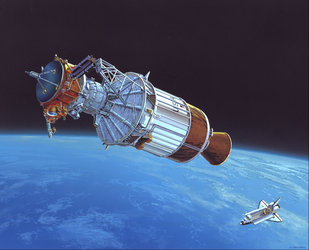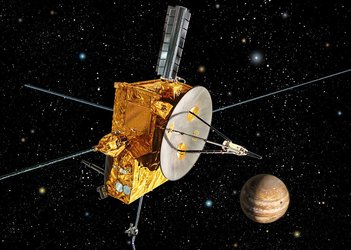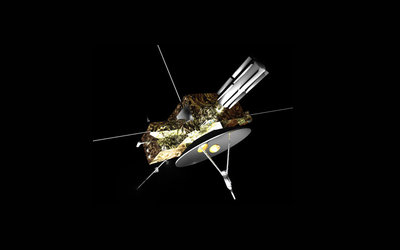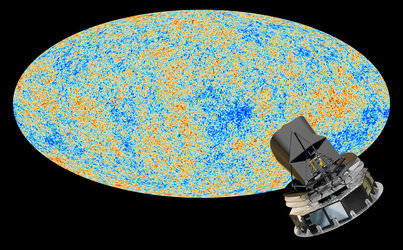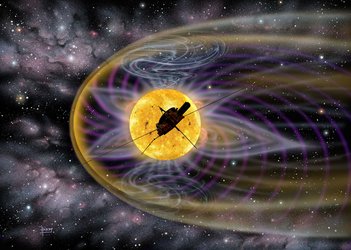Joint ESA/NASA Ulysses mission to end
Upon receipt of the last command from Earth, the transmitter on Ulysses will switch off on 30 June, bringing one of the most successful and longest missions in spaceflight history to an end.
After 18.6 years in space and defying several earlier expectations of its demise, the joint ESA/NASA solar orbiter Ulysses will achieve 'end of mission' on 30 June 2009. The final communication pass with a ground station will start at 17:35 CEST and run until 22:20 CEST (15:35-20:20 UTC) or until the final command is issued to switch the satellite's radio communications into 'monitor only' mode. No further contact with Ulysses is planned.
Ulysses is the first spacecraft to survey the environment in space above and below the poles of the Sun in the four dimensions of space and time. Among many other ground-breaking results, the hugely successful mission showed that the Sun's magnetic field is carried into the Solar System in a more complicated manner than previously believed. Particles expelled by the Sun from low latitudes can climb up to high latitudes and vice versa, even unexpectedly finding their way down to planets.
Expanding our understanding of the Sun
This is very important as regions of the Sun not previously considered as possible sources of hazardous particles for astronauts and satellites must now be taken into account and carefully monitored.
"Ulysses has taught us far more than we ever expected about the Sun and the way it interacts with the space surrounding it," said Richard Marsden, ESA's Ulysses Project Scientist and Mission Manager.
The shut-down of the satellite is a joint decision of the two agencies and comes a year after the mission was expected to end.
Weakened power supply
A year ago, the satellite's power supply had weakened to the point that it was thought the low temperatures would cause the fuel lines to freeze up, rendering Ulysses uncontrollable.
This didn't happen immediately and spacecraft controllers realised that they could keep the fuel warm and circulating by performing a short thruster burn every two hours, an ingenious solution that has enabled Ulysses' science mission to continue. It was decided to maintain the spacecraft in operation using NASA's 70 m-diameter ground station network allocated on a 'spare-capacity' basis.
But as Ulysses has moved further from Earth, the communications bit-rate has gone down while other demands for the 70 m-diameter Deep Space Network stations have gone up. Most importantly, the overall return of scientific data has decreased to a level where it is hard to justify the cost of keeping Ulysses in operation.
Longevity a tribute to builders and operators

"We expected the spacecraft to cease functioning much earlier. Its longevity is a tribute to Ulysses's builders and the people involved in operations over the years," says Paolo Ferri, Head of the Spacecraft Operations Solar and Planetary Missions Division.
He added that, "Although it is always hard to take the decision to terminate a mission, we have to accept that the satellite is running out of resources and a controlled switch-off is the best ending."
Final mission operations will be conducted from the Ulysses Mission Support Area (MSA) located at NASA's Jet Propulsion Laboratory in California, USA. The joint team will include Nigel Angold, ESA Mission Operations Manager, and Ed Massey, NASA Project Manager, as well as a number of engineers and analysts from both Agencies.
"Tuesday will be a very sad day when we send the last commands to Ulysses," said Angold. "But I'm very proud that we have overcome the many challenges that have come our way over the course of nearly two decades. Its longevity is an indication of the desire for international collaboration on space missions. ESA and NASA are to be commended for supporting this unique mission until the very end," he added.
After shut-off, Ulysses will continue to orbit the Sun, becoming in effect a man-made 'comet'.
"Whenever any of us look up in the years to come, Ulysses will be there, silently orbiting our star, which it studied so successfully during its long and active life," said Marsden.















 Germany
Germany
 Austria
Austria
 Belgium
Belgium
 Denmark
Denmark
 Spain
Spain
 Estonia
Estonia
 Finland
Finland
 France
France
 Greece
Greece
 Hungary
Hungary
 Ireland
Ireland
 Italy
Italy
 Luxembourg
Luxembourg
 Norway
Norway
 The Netherlands
The Netherlands
 Poland
Poland
 Portugal
Portugal
 Czechia
Czechia
 Romania
Romania
 United Kingdom
United Kingdom
 Slovenia
Slovenia
 Sweden
Sweden
 Switzerland
Switzerland




























